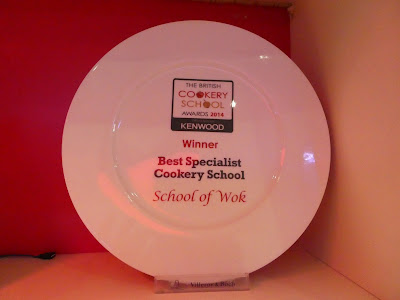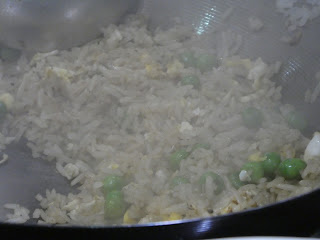Chef Jeremy Pang wasn’t always a chef. But after
other careers, he decided his passion for food, and Chinese food in particular,
was too hard to resist. Born to parents from Guangdong (Canton) and Shanghai
who lived in Hong Kong but moved to the UK in the 1960s, Jeremy was surrounded
by a family of food fanatics, or as he describes then “hungry passionate people
with a desire to share good food”. He has recently published a collection of
authentic Chinese recipes in his cookbook Chinese Unchopped.
Initially founded in 2009 as a mobile cookery
school, Jeremy started School of Wok in London, running classes in peoples’ own
kitchens. But his vision was a specialist professional kitchen for his students
to learn and practice their skills, doing real hands-on cooking. School of Wok
opened in May 2012 a stone’s throw from Chinatown and has been running classes
for the public and for corporate team building events ever since. Their last
big client was the cast and crew from London musical School of Rock, so
naturally Jeremy wanted us to practice our Wok Star moves!
Our class, full of food bloggers, writers and food
instagrammers, would focus on making three wok based dishes; fried prawn
wontons, egg fried rice and Sichuan stir fried chicken. My cooking partner was
Kavita of Kavey Eats blog, a good friend and fellow home cooking enthusiast
(although I confess she is far more skilled than I am!).
We would be road testing the new School of Wok
cooking utensil range focusing on the traditional carbon steel wok, much
beloved by Chinese people around the world. We were reminded that non-stick
woks are not authentic, however convenient they may be. Although with care, a
rust prone carbon steel wok can be kept in tip top condition.
First up was knife skills. We were handed some pretty
scary looking super sharp cleavers to prepare garlic, spring onions,
reconstituted dried shiitake mushrooms and peppers.
We were urged to ensure a steady grip on the
cleaver. The index finger should not be held along the blade of the cleaver.
The fingers should wrap around the handle of the cleaver. This would assist in
maintaining control of the implement, avoiding any accidents.
Obviously with the cleaver in your dominant hand,
you use your other hand to measure out the size of item to be chopped, using
your knuckles as a buffer to prevent fingers getting cut. Think of a crab
crawling, Jeremy urged us. Make sure the tips of your fingers are behind the
knuckle you are using as a guide. Chop by moving the cleaver forwards and down,
slowly, without raising the cleaver. Lifting the cleaver up high and bringing
it down results in bruised veggies and a greater risk of digit loss!
Next was forming the wontons. We used ready-made
wonton wrappers, available from any of the Chinese supermarkets in nearby
Chinatown. They need to be thawed out first, if frozen. Our filling would be a
mixture of finely chopped raw prawns, the diced reconstituted shiitake
mushrooms, garlic, ginger, coriander, spring onions, Chinese leaf, Chinese
chives with a little light soy sauce and sesame oil.
Water is used to form the seals, so you initially
place the skin in front of you in a diamond shape (ie with one of the corners
pointing down, and the opposite pointing up). One generous teaspoon of stuffing
is placed in the middle, and then the first seal is made by folding the bottom
corner over to the top to make a triangle.
The tip of the triangle is now the bottom. You
hold the two corners (of the flat end), and pull them together, sealing them
with a dab of water. The shape of a classic won ton, we were told, resembles
the ancient Chinese shape for a gold ingot, and that therefore eating won tons
would bring you wealth.
These cute little wontons would then be deep fried
at 170 degrees C for about 10 minutes (until golden brown and floating at the
top), and served with sweet chilli sauce.
Now for the wok action…
Ever thought that you can’t cook using a wok on an
induction hob? Think again! Not only does the School of Wok kitchen have the
most amazing purpose built single ring induction hob for a wok, complete with
sunken cubby hole for placing your wok for maximum stability, but there are
also specialist wok rings made for conventional flat induction hobs.
Next up was the main course of egg fried rice and
Szechuan chicken. Because we would be using the same wok to make both dishes,
we would make the rice first, keep it warm in a lidded earthenware pot and then
move on to the chicken. This would not be a problem because, as Jeremy
instructed us, wok cooked dishes should not take more than five minutes to
cook, as all the preparation is done in advance.
The secret to good egg fried rice is, apparently,
to use only 80% of the normal amount of water to cook the rice. The cooked rice
should be made in advance, and the other ingredients (petit pois, spring
onions, light soy sauce and vegetable oil) should be prepared or to hand for
quick addition to the smoking hot wok.
Oil is heated until smoking to the wok, then the
egg is cracked in. It should be stirred around quickly, and folded over to
prevent burning. Stirring, folding and the “wok toss” are three key moves to
prevent the wok from overheating and your ingredients burning.
The egg then gets pushed to the far side of the wok,
to keep warm but stop the cooking process. A little more oil is added, and when
smoking, the rice goes in. The rice needs to be mixed, stirred and prodded if
necessary to separate out the grains and the egg comes back in. Within seconds,
the peas are added and mixed. The rice should now be getting hot enough that it
trembles slightly in the wok, or “dancing” as Jeremy describes it. Now it
should be seasoned with a good dribble of light soy sauce, mixed thoroughly and
finally dressed with a dash of sesame oil.
Now for the Szechuan chicken. The chicken thigh (or
breast) is marinaded in advance in sesame oil, sugar, Chinese 5 spice, light
soy sauce and cornflour. A cooking sauce of hoi sin sauce, light soy sauce,
Chinese rice wine and chilli paste (or chilli bean paste – both are available
in Chinese grocery shops) is prepared and reserved to ensure it can be added
rapidly.
The other ingredients are crushed Szechuan
peppercorns, finely chopped garlic, finely chipped Birdseye chilli, sliced
pepper, sliced onions and cashew nuts. Jeremy advises you use a large round
plate to place the ingredients clockwise around the plate in the order you
intend to add them to the cooking process; his “wok clock”.
The cooking is hot, fast and frenetic. It is useful
to have someone helping you to chuck in the ingredients in order so that all
you have to do whilst cooking is manage the heat, cooking and avoiding things
burning. Remember the stirring, folding and wok toss to reduce the heat in the
super hot wok!
You put the onions and peppers in first, cook for a
couple of minutes. The garlic and Szechuan peppercorns follow, chilli, then
chicken. This needs a quick sear to seal and caramelise. Then the cashews go
in, swiftly followed by the sauce. Once the sauce is bubbling, you can relax a little,
as while the sauce is thickening, the chicken properly cooks through, provided
you keep the heat up. Lastly, the spring onions are thrown in and stirred
around to add crunch and flavour.
 |
| An expert demonstrates the Wok Toss - thank you, Jeremy! |
The results were superb. Vegetables just cooked,
enough sauce to coat chicken and flavour rice. Rice jewelled with morsels of egg
but not cloyingly eggy. Jeremy’s instructions are clear, logical and well
explained. Not only are they foolproof, but the rationale behind them is
carefully explained for those of us who need to understand the “why” behind the
how in cooking. Jeremy is a patient and watchful tutor, carefully monitoring
his charges and offering feedback and instruction in a friendly and supportive
manner whenever needed.
The School of Wok carbon steel wok was light, easy
to use and obviously suited to this type of cooking. Made by Dexam, and
available from School of Wok directly as well as John Lewis, it is a kitchen
accessory great for those seeking to attain Wok Star status!
 |
| Thank you Chef Jeremy Pang for a fab cooking class! |
Snigdha attended the cooking class at School of Wok
as their guest. Snigdha’s review of the cooking class represents her genuine
opinion of the session. Snigdha has received no incentive, financial or otherwise
for the posting of this review.

























This is a brilliant blog! .Very useful set of information. Reconditioned AGA
ReplyDeletenice post..
ReplyDeletetypes of chefs